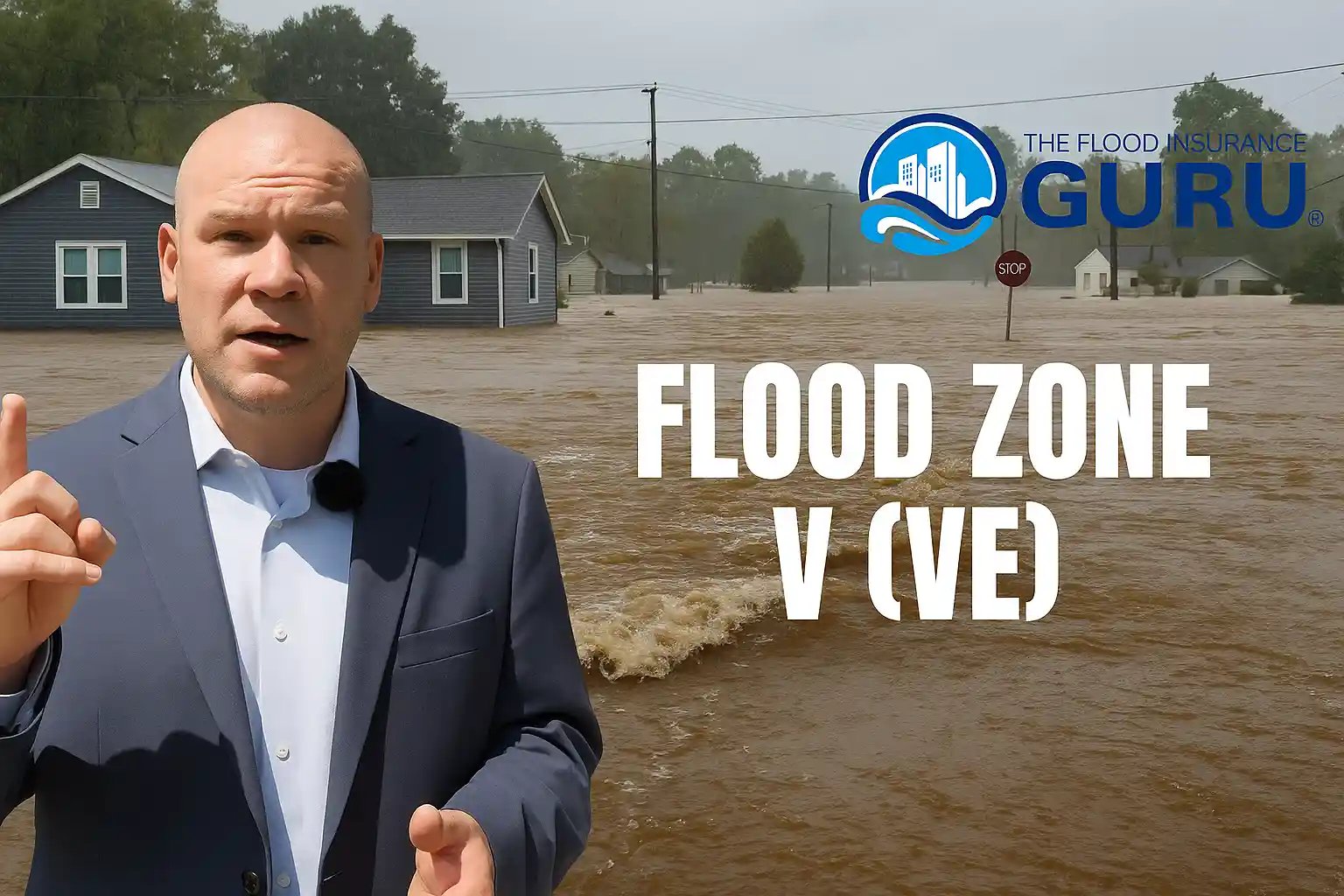Flood Zone V (VE): Coastal High‑Risk — What It Means & How to Lower Costs
Zone V/VE properties face high‑velocity wave action. Lenders require coverage, and pricing depends heavily on elevation and foundation. We verify your zone, compare NFIP vs. private, and advise on coastal‑specific mitigation so you can protect your investment.
At The Flood Insurance Guru, we understand the unique challenges that come with owning property in a coastal flood zone. Our expertise helps homeowners navigate complex FEMA maps, evaluate coverage options, and implement strategies that reduce both risk and insurance costs.

Visit or mail us
155 Bankers Blvd, Suite D200
Monroe, GA 30655 • United States
Weekdays 9:00–5:00
What we’ll do first
- Confirm VE vs. Coastal AE and building footprint
- Run NFIP & private quotes; review EC if available
- Advise on elevation of lowest horizontal member, breakaway walls, and open foundations
What Is Flood Zone V (VE)?
Flood Zone V (including VE) is a coastal high‑risk zone subject to high‑velocity wave action. FEMA maps VE where wave heights of approximately 3 feet or more are expected during the base flood. These areas require stricter building standards than inland zones.
Lender Requirements in Zone V/VE
- Federally backed mortgages require flood insurance when any part of the structure is in V/VE.
- Many communities require homes to be elevated on piles/posts/piers with open foundations in VE.
- Breakaway walls are allowed for enclosures below elevated floors but must be non‑structural and designed to fail under flood loads.
At The Flood Insurance Guru, we guide homeowners through these strict Zone V/VE requirements by confirming elevation compliance, reviewing structural details, and ensuring that insurance coverage aligns with both lender mandates and local building codes. Our expertise helps you avoid costly surprises while keeping your property and investment protected.
Flood Insurance: What is the Difference in Flood Zone A and Flood Zone V
Common Coastal Scenarios We See
VE vs. Coastal AE Confusion
Clients near the shoreline asking whether they’re truly in VE or coastal AE. We verify the panel and footprint and explain construction implications.
Premium Shock on Older Pilings
Older homes with low elevations or enclosed areas below the elevated floor often see higher NFIP rates; private options may help.
Enclosure/Breakaway Wall Questions
Owners wanting storage or parking below the elevated floor — we review breakaway wall rules and how they affect rating and safety.
Utility Equipment Below BFE
HVAC
and electrical below the elevated floor can increase damage. We recommend elevation and anchoring strategies.
Elevation Certificate Uncertainty
Not sure what “lowest horizontal structural member” means? We read your EC and explain how it drives VE pricing.
Major Remodels & Compliance
Substantial improvement thresholds can trigger elevation/mitigation requirements; we help plan for compliance and insurance impact.
VE Rating Drivers
NFIP & private factors
- Elevation of the lowest horizontal structural member relative to BFE (key in VE rating)
- Open vs. solid foundation; presence and design of breakaway walls
- Distance from shoreline; exposure and dune protection
- Enclosures/parking under the building and allowed uses
- Prior losses and construction year/materials
- Selected limits and deductibles
At The Flood Insurance Guru, we break down these VE rating factors for you, showing exactly how elevation, foundation type, and construction details influence both NFIP and private market pricing. By analyzing your property’s unique characteristics, we help you secure coverage that balances compliance, cost, and protection.
Flood Insurance EXPERT Reveals NFIP vs Private Differences
NFIP vs. Private Pricing
| Scenario | NFIP Example | Private Example | Notes |
|---|---|---|---|
| VE, elevated +3 ft over BFE (open foundation) | $2,200–$3,400/yr | $1,850–$3,000/yr | Elevation and open pilings help |
| VE, enclosure below elevated floor (breakaway) | $3,500–$5,200/yr | $3,000–$4,600/yr | Non‑structural walls; storage only |
| VE, older home near shoreline (+0–1 ft over BFE) | $4,800–$7,500/yr | $4,200–$6,800/yr | Elevation upgrades can reduce |
Confirm Your Zone
- Check the current FEMA map — Use the FEMA Map Service Center.
- Review effective dates — Ensure you’re on the latest panel for your community.
- Locate the building footprint — Requirements hinge on where the structure sits.
- Use our free Flood Risk Tool — Instantly check your address, see your zone, and get a preliminary risk rating in under a minute.

Elevation Certificates in VE
- Key data: lowest horizontal structural member, BFE, and foundation type
- ECs often unlock lower premiums when elevation is favorable
- We review ECs for rating opportunities and compliance issues
Mitigation for Coastal Homes
- Maintain open foundations on piles/posts/piers in VE
- Use engineered breakaway walls for limited storage/parking only
- Elevate and anchor utilities above BFE
- Consider freeboard (build 1–3 ft above BFE where feasible)
- Protect dunes and natural barriers; avoid grading that increases exposure
Buying or Selling in VE
Buyer checklist (before you close)
- Confirm VE status, EC availability, and elevation relative to BFE
- Get NFIP and private quotes using the same limits and deductibles
- Review enclosure/breakaway wall compliance
- Plan for utility elevation and insurance escrow costs
Seller tip
Provide ECs and documentation on foundation type and breakaway wall design to streamline underwriting and keep deals moving.

FAQs
Is flood insurance required in Zone V/VE?
Yes, for federally backed mortgages when any part of the structure is in V/VE.
What’s the biggest factor in VE pricing?
The elevation of the lowest horizontal structural member relative to BFE, plus foundation/enclosure details.
Do flood vents reduce premiums in VE?
Standard flood vents used in AE enclosures aren’t the focus in VE. Instead, VE relies on open foundations and engineered breakaway walls below the elevated floor.
Can private carriers be cheaper for VE?
Often, yes — depending on elevation, construction, and distance from the shoreline. We quote both markets.
Get a Free VE Flood Zone Review
Send your address and any ECs you have. We’ll verify your zone, compare pricing, and outline the fastest path to lower costs and better protection.


